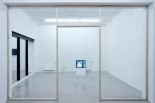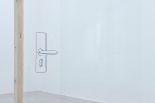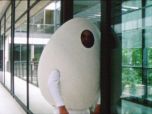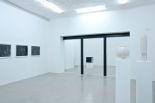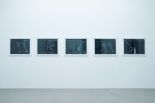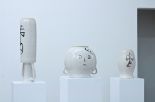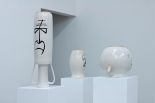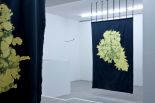| 27.1. - 31.03.2012 | Judith Hopf |
|
Fotos: Johanna Glösl | Courtesy: Grazer Kunstverein
27.1. - 31.03.2012 | Judith Hopf: end rhymes and openings
Eröffnung | Opening
Ein Ei wandert durch Judith Hopfs Film Some End of Things: The Conception of Youth (2011), schreitet stoisch durch das Atrium einer modernistischen Architektur, steigt die Treppen herauf, läuft die Gänge und Verbindungsbrücken ab, spiegelt sich en passant in den Rastern der Fassade – bis es schließlich an dem Versuch scheitert, sich Einlass in das Gefüge aus Glas, Stahl und Beton zu verschaffen. Das Ei ist zu groß, die Tür zu klein und die Körper zu hart, um nachzugeben – eine Idee verkantet sich in der Struktur der normierten Welt. Das Aufeinandertreffen der Formen als Zuspitzung der Widersprüche gegenwärtiger Verhältnisse verweist auf ein zentrales Thema der Arbeiten von Judith Hopf. In einer Welt, in der alles flüssig zu werden scheint – die Kommunikation, die Arbeit, der Kapitalismus – geht Hopf den harten Kanten nach, die das Feld des Sozialen trotz aller Prozesse der Entmaterialisierung und Enthierarchisierung nach wie vor prägen, die Körper und Identitäten normieren und dem Einzelnen seinen Platz zuweisen. Im Blickfeld der Kontrollgesellschaft erkundet sie die Grenzziehungen zwischen sozialer Teilhabe und kulturellem Ausschluss, tastet den verschwindenden Horizont alternativer Lebensformen ab und eröffnet einen Denk- und Erfahrungsraum jenseits der Logiken der (Selbst-)Disziplinierung. Formale Fragestellungen schlagen hier in ethische um, während sich die Ordnungen des Politischen unter der Hand im Materiellen manifestieren. Judith Hopfs Blick auf gesellschaftliche Prozesse ist dabei ein entschieden schräger: Es geht ihr ausdrücklich nicht um die unmittelbare Abbildung sozialer oder politischer Tatsachen im Medium der Kunst. Vielmehr bedient sie sich der Kunst als eines autonomen Raumes, innerhalb dessen die Verhältnisse zum Tanzen gebracht werden können. Denn gerade indem ihre Arbeiten ästhetische Autonomie beanspruchen, erspielen sie sich die Möglichkeit, auf produktive Weise an den gegenwärtigen Diskursen vorbei zu reden. Das Slapstickhafte, das Komödiantische und das Karikatureske dienen ihr als Mittel, Brüche und Öffnungen in der Ordnung der Dinge zu provozieren, die die eingespielten Routinen der Interpretation – seien diese nun politischer oder ästhetischer Natur – entgleisen lassen. In dieser Perspektive kann auch die Vielgestaltigkeit von Judith Hopfs Werk im Ganzen als eine Strategie der permanenten Selbst-Provokation gelesen werden: Der kontinuierliche Wechsel der Medien – von Installation und Skulptur, über Film, Video und Performance bis hin zu grafischen und keramischen Arbeiten – wie auch die von ihr immer wieder gesuchte Zusammenarbeit mit anderen Künstlerinnen und Künstlern stellen die Sedimentierungen ihrer eigenen Praxis immer wieder auf die Probe und erschließen so immer neue Räume der künstlerischen Produktivität.
Veranstaltungen/Events: Filmscreening mit Judith Hopf CMRK
Ausstellungen im Dialog
(English version)
Judith Hopf, end rhymes and openings
An egg wanders through Judith Hopf’s film Some End of Things: The Conception of Youth (2011), strides stoically through the atrium of a modernist architecture, climbs the stairs, traverses passageways and connecting bridges, is mirrored by the grids of the facade in passing – until it finally fails in its attempt to gain entry into the edifice of glass, steel and concrete. The egg is too big, the door too small, and the bodies too hard to give way – an idea is caught in the structure of the standardized world. The confrontation of forms as an intensification of the contradictions of contemporary conditions points to a central theme in Judith Hopf’s work. In a world where everything seems to be in flux – communication, work, capitalism – Judith Hopf pursues the hard edges that still mark the field of the social despite all processes of dematerialization and de-hierarchization, standardizing bodies and identities and assigning each individual to its place. Within the field of vision of the control society, she explores demarcations between social participation and cultural exclusion, probes the vanishing horizon of alternative forms of living, and opens up a space of experience beyond the logics of (self-) discipline. Formal questions turn into ethical issues here, while the orders of the political surreptitiously manifest themselves in the material. In this, Judith Hopf’s view of social processes is a decidedly skewed one: she is expressly not interested in the immediate depiction of social or political facts in the medium of art. Instead, she makes use of art as an autonomous space, within which the circumstances can be made to dance. Specifically by claiming aesthetic autonomy, her works gain the possibility for themselves to productively circumvent contemporary discourses. Slapstick, comedy and caricature serve the artist as means for provoking ruptures and openings in the order of things, derailing well-rehearsed routines of interpretation – whether they are of a political or an aesthetic nature. In this perspective, the diversity of Judith Hopf’s oeuvre as a whole can also be read as a strategy of permanent self-provocation: the continuous change of media – from installation and sculpture, through film, video and performance, all the way to graphical and ceramic works – and the collaboration with other artists that she seeks again and again repeatedly challenge the sedimentations of her own practice, thus opening up ever new spaces of productivity.
Judith Hopf (*1969) lives and works in Berlin.
Film Screening with Judith Hopf CMRK Exhibitions in Dialogue
|




